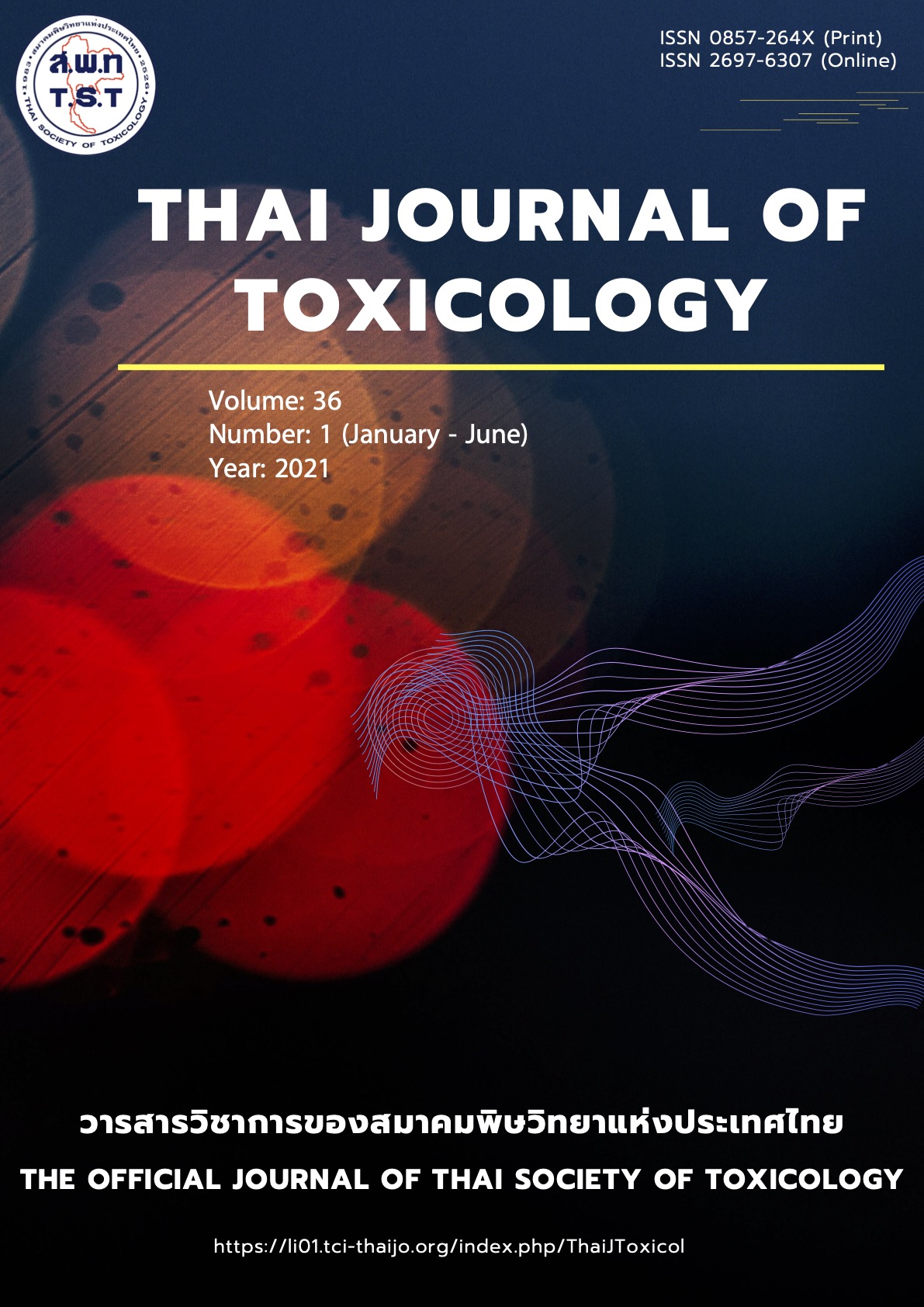Health Risk Assessment on Exposure to Polycyclic Aromatic Hydrocarbon (PAHs) of Workers in Different Positions of Restaurants: A Case Study in Kitchens of Golf Clubs and Tourist Dams
Main Article Content
Abstract
Polycyclic Aromatic Hydrocarbon (PAHs) were gradually an important pollution problem from a cooking process which causes health impact and cancer. This study aimed to assess the health risk on exposure to PAHs of workers in different positions in restaurants by using a case study of kitchens of golf clubs and tourist dams. The concentrations of PAHs were monitoring from seven kitchens following NIOSH method 5515, and analyzed with Gas Chromatography-Mass Spectrometry (GC-MS). The carcinogenic risk assessment was calculated and a risk matrix was applied for occupational health risk assessment. The results showed that total PAHs average concentration of seven kitchens was 567.14±386.38 ng/m3 (150 - 1,020 ng/m3). The cancer risk assessment calculated from Benzo[a]pyrene exposure of different positions indicated an acceptable risk (<2.5 x10-6) which were highest in chef 3.82 - 6.62 x 10-12, followed by 3.43 - 4.97 x 10-12, 2.13 - 3.24 x 10-12 and 1.06 - 1.86 x 10-12 for the chef assistant, waitress, and cashier, respectively. The result was consistent with an assessment by the occupational health risk matrix that indicated an acceptable risk of all positions. The results recommend a health surveillance program for workers by application of occupational health risk assessment in a long term exposure to PAHs according to potential risk on exposure from cooking activities. Workers should be aware of Benzo[a]pyrene exposure and promoted awareness of self-protection with appropriate PPE use i.e. mask P95 to prevent fine dust and PAHs exposure while cooking and good ventilation design to reduce PAHs pollution.
Article Details
References
The Centers for Disease Control and Prevention (CDC). Polycyclic Aromatic Hydrocarbons (PAHs). Available at https://www.epa.gov/north-birmingham-project/polycyclic-aromatic-hydro carbons-pahs-fact-sheet, accessed January 1, 2018.
World health organization (WHO). Risk factors for chronic respiratory diseases. Available at http://www.who.int/gard/publications/Risk%20factors.pdf, accessed January 1, 2018.
United States Environmental Protection Agency. Toxicological review of benzo[a]pyrene. Available at https://cfpub.epa.gov/ncea/iris/iris _documents/documents/ toxreviews/0136tr.pdf, accessed January 1, 2020.
Abdel-Shafy HI, Mansour MSM. A review on polycyclic aromatic hydrocarbons: Source, environmental impact, effect on human health and remediation. Egypt J Petroleum 2016; 25(1): 107-23.
Straif K, Baan R, Grosse Y, et al. Carcinogenicity of household solid fuel combustion and high-temperature frying. Lancet Oncol 2006; 7(12): 977-78.
Zhang Q, Gangupomu RH, Ramirez D, et al. Measurement of ultrafine particles and other air pollutants emitted by cooking activities. Inter J Environ Res Publ Health 2010; 7(4): 1744–59.
Goel A, Ola D, Veetil AV. Burden of disease for workers attributable to exposure through inhalation of PPAHs in RSPM from cooking fumes. Environ Sci Pollut Res 2019; 26(9): 8885–94.
อารุญ เกตุสาคร, นรุตตม์ สหนาวิน. ความสัมพันธ์ระหว่างสารโพลิไซคลิกอะโรมาติกไฮโดรคาร์บอนและ PM10 กับปัจจัยด้านสภาพแวดล้อม: กรณีศึกษาในสถานประกอบพิธีกรรมทางศาสนาในจังหวัดปทุมธานี. วารสาร วิชาการพระจอมเกล้าพระนครเหนือ 2560; 27(3): 493–500.
Navasumrit P, Arayasiri M, Hiang OMT, et al. Potential health effects of exposure to carcinogenic compounds in incense smoke in temple workers. Chem-Biol Interac 2008; 173(1): 19–31.
ณัฐชัย ภาณุโสภณ, พรพิมล กองทิพย์, วิทยา อยู่สุข, และคณะ. การประเมินความเสี่ยงต่อสุขภาพของพนักงานที่สัมผัสกับ โพลิไซคลิก อะโรมาติก ไฮโดรคาร์บอน ในโรงงานหลอมกระบี่. งานประชุมวิชาการระดับชาติมหาวิทยาลัยรังสิต; 29 เมษายน 2559:134–9. doi: 10.14458 /RSU.res.2016.89.
Ruchirawat M, Settachan D, Navasumrit P, et al. Assessment of potential cancer risk in children exposed to urban air pollution in Bangkok, Thailand. Toxicol Lett 2007; 168(3): 200–9.
National Institute for Occupational Safety and Health (NIOSH). Polynuclear aromatic hydrocarbons by GC. Available at https://www.cdc.gov/niosh/docs/2003-154/meth od-cas2.html, accessed January 1, 2019.
Chaiklieng S, Pimpasaeng C, Thapphasaraphong S. Benzene exposure at gasoline stations - health risk assessment. Hum Ecol Risk Assess 2015; 21(8): 2213-22.
US. Environmental Protection Agency. Risk assessment guidance for superfund volume I: Human health evaluation manual (Part F, supplemental guidance for inhalation risk assessment), final, Washington, D.C., 2009. Available at https://www.epa.gov/sites/ production/files/2015-09/documents/partf_2009 01_final.pdf, accessed Jan 17, 2018.
ACGIH. TLVs and BEIs. Based on the documentation of the threshold limit values for chemical substances and physical agents and biological exposure indices. ACGIH: Cincinnati, OH, USA, 2019.
Feng S, Shen X, Hao X, et al. Polycyclic and nitro-polycyclic aromatic hydrocarbon pollution characteristics and carcinogenic risk assessment of indoor kitchen air during cooking periods in rural households in North China. Environ Sci Pollut Res Int. 2021; 28(9):11498-508.
Bortey-Sam N, Ikenaka Y, Akoto O, et al. Oxidative stress and respiratory symptoms due to human exposure to polycyclic aromatic hydrocarbons (PAHs) in Kumasi, Ghana. Environ Pollut. 2017; 228: 311–20.
ราชกิจจานุเบกษา. กฎกระทรวงกําหนดมาตรฐานในการบริหารจัดการและดําเนินการด้านความปลอดภัย อาชีวอนามัยและสภาพแวดล้อมในการทํางานเกี่ยวกับความร้อน แสงสว่าง และเสียง พ.ศ. 2559, เล่ม 133 ตอนที่ 91 ก (2559).
Singapore Standard SS 554. Code of Practice for Indoor Air Quality for air-conditioned buildings. Singapore: SPRING Singapore, 2009.
มธุรส ประสมวงค์, วันอัสมีน โฮ, ธิดารัตน์ บุญช่วย และคณะ. คุณภาพอากาศภายในอาคารโรงแรมและกลุ่มอาการเจ็บป่วยของพนักงานโรงแรม จังหวัดสุราษฎร์ธานี. วารสารวิทยาศาสตร์และเทคโนโลยี มหาวิทยาลัยอุบลราชธานี 2561; 20(3): 64-73.
Wei See S, Karthikeyan S, Balasubramanian R. Health risk assessment of occupational exposure to particulate-phase polycyclic aromatic hydrocarbons associated with Chinese Malay and Indian cooking. J Environmental Monitoring 2006; 8(3): 369.
Masuda M, Wang Q, Tokumura M, et al. Risk assessment of polycyclic aromatic hydrocarbons and their chlorinated derivatives produced during cooking and released in the exhaust gas. Ecotox Environ Saf 2020; 197: 110592.
Ding J, Zhong J, Yang Y, et al. Occurrence and exposure to polycyclic aromatic hydrocarbons and their derivatives in a rural Chinese home through biomass fuelled cooking. Environmental Pollution, Interactions between Indoor and Outdoor Air Pollution - Trends and Scientific Challenges 2012; 169: 160-6.
Bhargava A, Khanna RN, Bhargava SK, et al. Exposure risk to carcinogenic PAHs in indoor-air during biomass combustion whilst cooking in rural India. Atmos Environ 2004; 38(28): 4761–7.
Yu K-P, Yang KR, Chen YC, et al. Indoor air pollution from gas cooking in five Taiwanese families. Build Environ. 2015; 93: 258–66.
Zhao P, Yu K-P, Lin C-C. Risk assessment of inhalation exposure to polycyclic aromatic hydrocarbons in Taiwanese workers at night markets. Inter Arch Occup Environ Health 2010; 84(3): 231-7.
Kim K-H, Pandey S, Kabir E, et al. The modern paradox of unregulated cooking activities and indoor air quality. J Hazardous Material 2011; 195: 10p. https://doi.org/10.1016/j.jhazmat. 2011.08.037.
Wu M-T, Lin P-C, Pan C-H, et al. Risk assessment of personal exposure to polycyclic aromatic hydrocarbons and aldehydes in three commercial cooking workplaces. Sci Rep 2019; 9(1): 1661.


